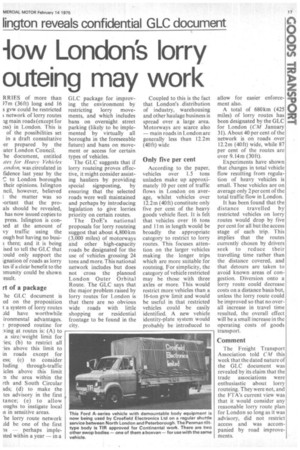lington reveals confidential GLC document
Page 19

If you've noticed an error in this article please click here to report it so we can fix it.
low London's lorry outeing may work
R RIES of more than )7m (36ft) long and 16 s gvw could be restricted network of lorry routes ig main roads (except for .tss) in London. This is of the possibilities set in a draft consultative er prepared by the :ater London Council. 'he document, entitled 4tes for Heavy Vehicles .ondon, was circulated in fidence last year by the C to London boroughs their opinions. Islington ncil, however, believed the matter was so rortant that the proals should be revealed, has now issued copies to press. Islington is conled at the amount of vy traffic using the ough but having no busi3, there; and it is being ised to tell the GLC that cotild only support the ignation Of roads as lorry tes if a dear benefit to the imunity could be shown .esult.
rt of a package
he GLC document is ed on the proposition t a system of lorry routes 31d have worthwhile ironmental advantages.
proposed routine for .ving at routes is: (A) to a size/weight limit for ies; (b) to restrict all -les above this limit to in roads except for ess; (c) to consider luding through-traffic. ides above this limit ii the area within the rth and South Circular ads; (d) to make the tes advisory in the first tance; (e) to allow oughs to instigate local Ls in sensitive areas.
'he lorry route network ild be one of the first is -perhaps impleited within a year — in a GLC package for improving the environment by restricting lorry movements, and which includes bans on overnight street parking (likely to be implemented by virtually all boroughs in the foreseeable future) and bans on movement or access for certain types of vehicles.
The GLC suggests that if lorry routeing proves effective, it might consider assisting hauliers by providing special signposting, by ensuring that the selected roads were well Maintained and perhaps by introducing legislation to give lorries priority on certain routes.
The DoE's national proposals for lorry routeing suggest that about 4,800km (3,000 miles) of motorways and other high-capacity roads be designated for the use of vehicles grossing 24 tons and more. This national network includes but does not cross the planned London Outer Orbital Route. The GLC says that the major problem raised by lorry routes for London is that there are no obvious wide roads with little shopping or residential frontage to be found in the city. Coupled to this is the fact that London's . distribution of industry, warehousing and other haulage business is spread over a large area. Motorways are scarce also — main roads in London are generally less than 12.2m (40ft) wide
Only five per cent
According to the paper, vehicles over 1.5 tons unladen make up approximately 10 per cent of traffic flows in London on average, whilst vehicles over 12.2m (40ft) constitute only five per cent of the heavy goods vehicle fleet. It is felt that vehicles over 16 tons and II m in length would be broadly the . appropriate category to restrict to lorry routes. This focuses attention on the larger vehicles making the longer trips which are more suitable for routeing. For simplicity, the category of vehicle restricted may be those with three axles or more. This would restrict more vehicles than a 16-ton gvw limit and would be useful in that restricted vehicles could be easily identified, A new vehicle identity-plate system would probably be introduced to allow for easier enforcement also.
A total of 680km (425 miles) of lorry routes has been designated by the GLC for London (CM January 31). About 40 per cent of the network is on roads over 12.2m (40ft) wide, while 87 per cent of the routes are over 9.14 m (30ft).
Experiments have shown that changes in total vehicle flow resulting from regulation of heavy vehicles is small. These vehicles are on average only 2 per cent of the total traffic flow in London.
It has been found that the distance travelled by restricted vehicles on lorry routes would drop by five per cent for all but the access stage of each trip. This implies that the routes currently chosen by drivers seek to reduce their travelling time rather than the distance covered, and that detours are taken to avoid known areas of congestion. Diversion onto a lorry route could decrease costs on a distance basis but, unless the lorry route could be improved so that no overall increase in travel time resulted, the overall effect will be a small increase in the operating costs of goods transport.
Comment
The Freight Transport Association told CM this week that the dated nature of the GLC document was revealed by its claim that the trade associations were enthusiastic about lorry routeing. They were not, and the FTA's current view was that it would consider any reasonable lorry route plan for London so long as it was advisory, did not restrict access and was accompanied by road improvements.




































































































